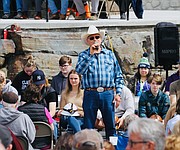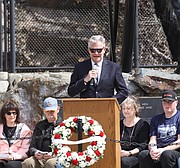50 years later …
BIG CREEK — Ninety-one hardhats, all of them lined up in rows — sitting atop an empty chair.
Each one of them representing a man.
Fathers …
Sons …
Grandfathers …
Brothers …
Uncles …
They are the 91 men who didn’t come home at the end of May 2, 1972.
On Monday morning, nearly 1,000 people made their way to the Sunshine Miners Memorial to remember them on the 50th anniversary of Idaho’s greatest disaster.
The ceremony itself began almost exactly 50 years to the minute that men began evacuating the mine at 11 a.m., the early moments of what would come to be known as the Sunshine Mine Disaster.
It is Idaho’s Titanic, our Hindenburg, our unfortunate chapter in the history books. But in a place that prides itself on resilience and the ability to come together as a community — there probably wasn’t a community that could’ve handled the situation better than the Silver Valley and its residents did five decades ago.
Before the advent of the internet, before information was at our literal fingertips, it was concerned family members waiting outside the mine itself, near radios, or watched news stations in black and white — waiting for any information that could be provided.
Idaho Gov. Brad Little, the keynote speaker during Monday’s ceremony, was an unassuming freshman at the University of Idaho on May 2, 1972.
“Today we remember the victims and their families of the devastating tragedy that happened 50 years ago today,” Little said. “The impact of the Sunshine Mine Disaster ripped through Idaho, across the Silver Valley and many of us still remember that May.”
Little discussed how mining has been the lifeblood of Idaho’s history, so much so that it’s part of the state seal.
“It’s a proud history, but not without tragedy — including the events of 50 years ago,” Little said. “I don’t remember exactly how the weather was on May 2, but it will forever be a day that we remember with a dark cloud.”
Little remembered how the tragedy happening 70 miles north of Moscow affected many of his classmates and friends — the ones from the Silver Valley who didn’t know if their relatives or friends were safe.
“I remember the gravity of what took place in this community and how they powered through it and went on just like communities do,” Little said. “I stand here today with many representatives from Idaho’s mining industry and we recognize the strides that these folks and the people that represent have made in mining safety. We do not need another disaster to spread change and improve conditions for our miners.”
The mining representatives that Little mentioned, representing the local mines currently in operation, as well as the local United Steelworkers Union, each spoke on how the Sunshine Mine Disaster shaped their industry.
As the ceremony wound down, the emotional moments only increased as family members made their way to the microphone to talk about their family members who didn’t come home.
Children who grew up without one of their parents and grandparents, some of them never meeting their fathers due to their mother being pregnant with them during the disaster.
Their words struck a chord with every person in the audience.
“I don’t know why these 91 men were called back to heaven, but time heals all wounds,” one said.
“The memory never goes away,” said another.
As the ceremony wrapped up, each name of one of the fallen miners was read aloud, followed by the extinguishing of a headlamp by a Kellogg High School student.







